Analysis of Budgeting Techniques for Snappy Drinks Plc Finance
VerifiedAdded on 2020/10/22
|12
|3465
|425
Report
AI Summary
This report provides a comprehensive analysis of business finance and budgeting techniques, focusing on the case of Snappy Drinks Plc, an international energy drink manufacturer. Part A of the report examines the purposes and process of budget preparation, including the development of budget assumptions, revenue forecasting, and departmental budgeting. It also explores the application and appropriateness of traditional budgeting approaches, such as fixed and incremental budgets. Part B delves into various budgetary tools, including rolling and zero-based budgets, outlining their advantages and disadvantages. The report then analyzes which budgeting method best suits the company's needs. The report concludes that, while traditional budgeting has its place, in today's dynamic business environment, Snappy Drinks Plc needs to consider more flexible and adaptive budgeting techniques for sustainable growth and effective financial planning. The report highlights the importance of adapting to changing circumstances and implementing regular adjustments for continued success.

BUSINESS FINANCE
Paraphrase This Document
Need a fresh take? Get an instant paraphrase of this document with our AI Paraphraser
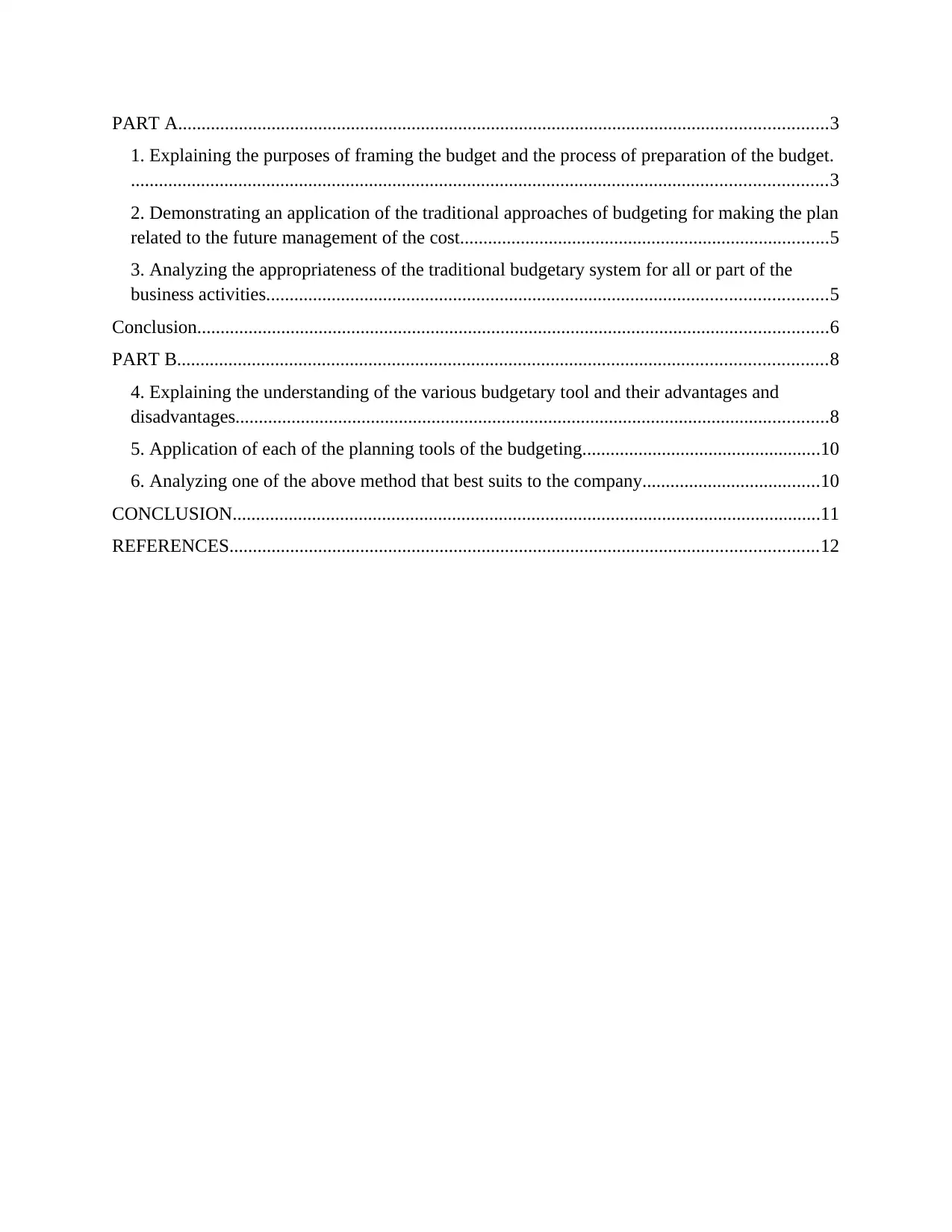
PART A...........................................................................................................................................3
1. Explaining the purposes of framing the budget and the process of preparation of the budget.
.....................................................................................................................................................3
2. Demonstrating an application of the traditional approaches of budgeting for making the plan
related to the future management of the cost...............................................................................5
3. Analyzing the appropriateness of the traditional budgetary system for all or part of the
business activities........................................................................................................................5
Conclusion.......................................................................................................................................6
PART B...........................................................................................................................................8
4. Explaining the understanding of the various budgetary tool and their advantages and
disadvantages...............................................................................................................................8
5. Application of each of the planning tools of the budgeting...................................................10
6. Analyzing one of the above method that best suits to the company......................................10
CONCLUSION..............................................................................................................................11
REFERENCES..............................................................................................................................12
1. Explaining the purposes of framing the budget and the process of preparation of the budget.
.....................................................................................................................................................3
2. Demonstrating an application of the traditional approaches of budgeting for making the plan
related to the future management of the cost...............................................................................5
3. Analyzing the appropriateness of the traditional budgetary system for all or part of the
business activities........................................................................................................................5
Conclusion.......................................................................................................................................6
PART B...........................................................................................................................................8
4. Explaining the understanding of the various budgetary tool and their advantages and
disadvantages...............................................................................................................................8
5. Application of each of the planning tools of the budgeting...................................................10
6. Analyzing one of the above method that best suits to the company......................................10
CONCLUSION..............................................................................................................................11
REFERENCES..............................................................................................................................12
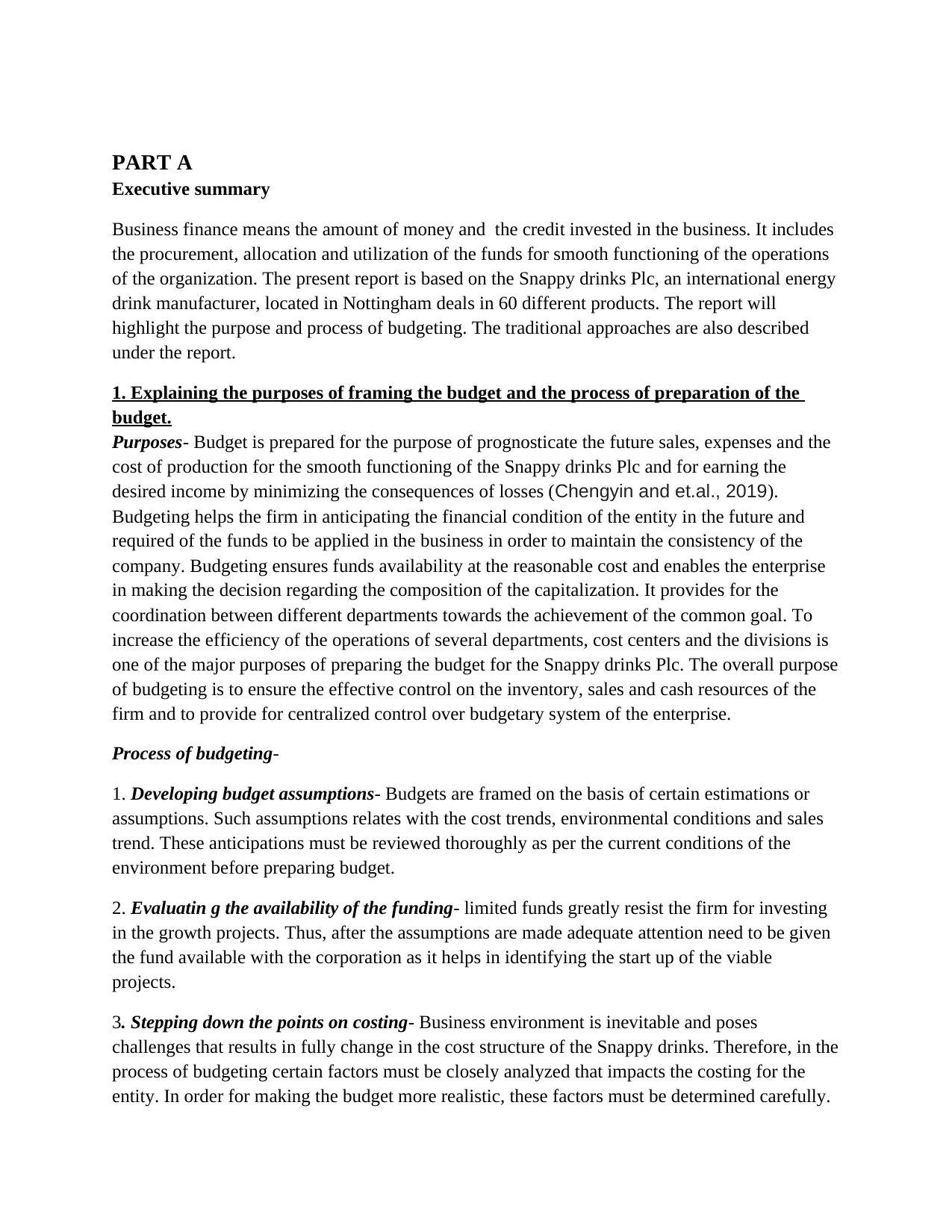
PART A
Executive summary
Business finance means the amount of money and the credit invested in the business. It includes
the procurement, allocation and utilization of the funds for smooth functioning of the operations
of the organization. The present report is based on the Snappy drinks Plc, an international energy
drink manufacturer, located in Nottingham deals in 60 different products. The report will
highlight the purpose and process of budgeting. The traditional approaches are also described
under the report.
1. Explaining the purposes of framing the budget and the process of preparation of the
budget.
Purposes- Budget is prepared for the purpose of prognosticate the future sales, expenses and the
cost of production for the smooth functioning of the Snappy drinks Plc and for earning the
desired income by minimizing the consequences of losses (Chengyin and et.al., 2019).
Budgeting helps the firm in anticipating the financial condition of the entity in the future and
required of the funds to be applied in the business in order to maintain the consistency of the
company. Budgeting ensures funds availability at the reasonable cost and enables the enterprise
in making the decision regarding the composition of the capitalization. It provides for the
coordination between different departments towards the achievement of the common goal. To
increase the efficiency of the operations of several departments, cost centers and the divisions is
one of the major purposes of preparing the budget for the Snappy drinks Plc. The overall purpose
of budgeting is to ensure the effective control on the inventory, sales and cash resources of the
firm and to provide for centralized control over budgetary system of the enterprise.
Process of budgeting-
1. Developing budget assumptions- Budgets are framed on the basis of certain estimations or
assumptions. Such assumptions relates with the cost trends, environmental conditions and sales
trend. These anticipations must be reviewed thoroughly as per the current conditions of the
environment before preparing budget.
2. Evaluatin g the availability of the funding- limited funds greatly resist the firm for investing
in the growth projects. Thus, after the assumptions are made adequate attention need to be given
the fund available with the corporation as it helps in identifying the start up of the viable
projects.
3. Stepping down the points on costing- Business environment is inevitable and poses
challenges that results in fully change in the cost structure of the Snappy drinks. Therefore, in the
process of budgeting certain factors must be closely analyzed that impacts the costing for the
entity. In order for making the budget more realistic, these factors must be determined carefully.
Executive summary
Business finance means the amount of money and the credit invested in the business. It includes
the procurement, allocation and utilization of the funds for smooth functioning of the operations
of the organization. The present report is based on the Snappy drinks Plc, an international energy
drink manufacturer, located in Nottingham deals in 60 different products. The report will
highlight the purpose and process of budgeting. The traditional approaches are also described
under the report.
1. Explaining the purposes of framing the budget and the process of preparation of the
budget.
Purposes- Budget is prepared for the purpose of prognosticate the future sales, expenses and the
cost of production for the smooth functioning of the Snappy drinks Plc and for earning the
desired income by minimizing the consequences of losses (Chengyin and et.al., 2019).
Budgeting helps the firm in anticipating the financial condition of the entity in the future and
required of the funds to be applied in the business in order to maintain the consistency of the
company. Budgeting ensures funds availability at the reasonable cost and enables the enterprise
in making the decision regarding the composition of the capitalization. It provides for the
coordination between different departments towards the achievement of the common goal. To
increase the efficiency of the operations of several departments, cost centers and the divisions is
one of the major purposes of preparing the budget for the Snappy drinks Plc. The overall purpose
of budgeting is to ensure the effective control on the inventory, sales and cash resources of the
firm and to provide for centralized control over budgetary system of the enterprise.
Process of budgeting-
1. Developing budget assumptions- Budgets are framed on the basis of certain estimations or
assumptions. Such assumptions relates with the cost trends, environmental conditions and sales
trend. These anticipations must be reviewed thoroughly as per the current conditions of the
environment before preparing budget.
2. Evaluatin g the availability of the funding- limited funds greatly resist the firm for investing
in the growth projects. Thus, after the assumptions are made adequate attention need to be given
the fund available with the corporation as it helps in identifying the start up of the viable
projects.
3. Stepping down the points on costing- Business environment is inevitable and poses
challenges that results in fully change in the cost structure of the Snappy drinks. Therefore, in the
process of budgeting certain factors must be closely analyzed that impacts the costing for the
entity. In order for making the budget more realistic, these factors must be determined carefully.
⊘ This is a preview!⊘
Do you want full access?
Subscribe today to unlock all pages.

Trusted by 1+ million students worldwide
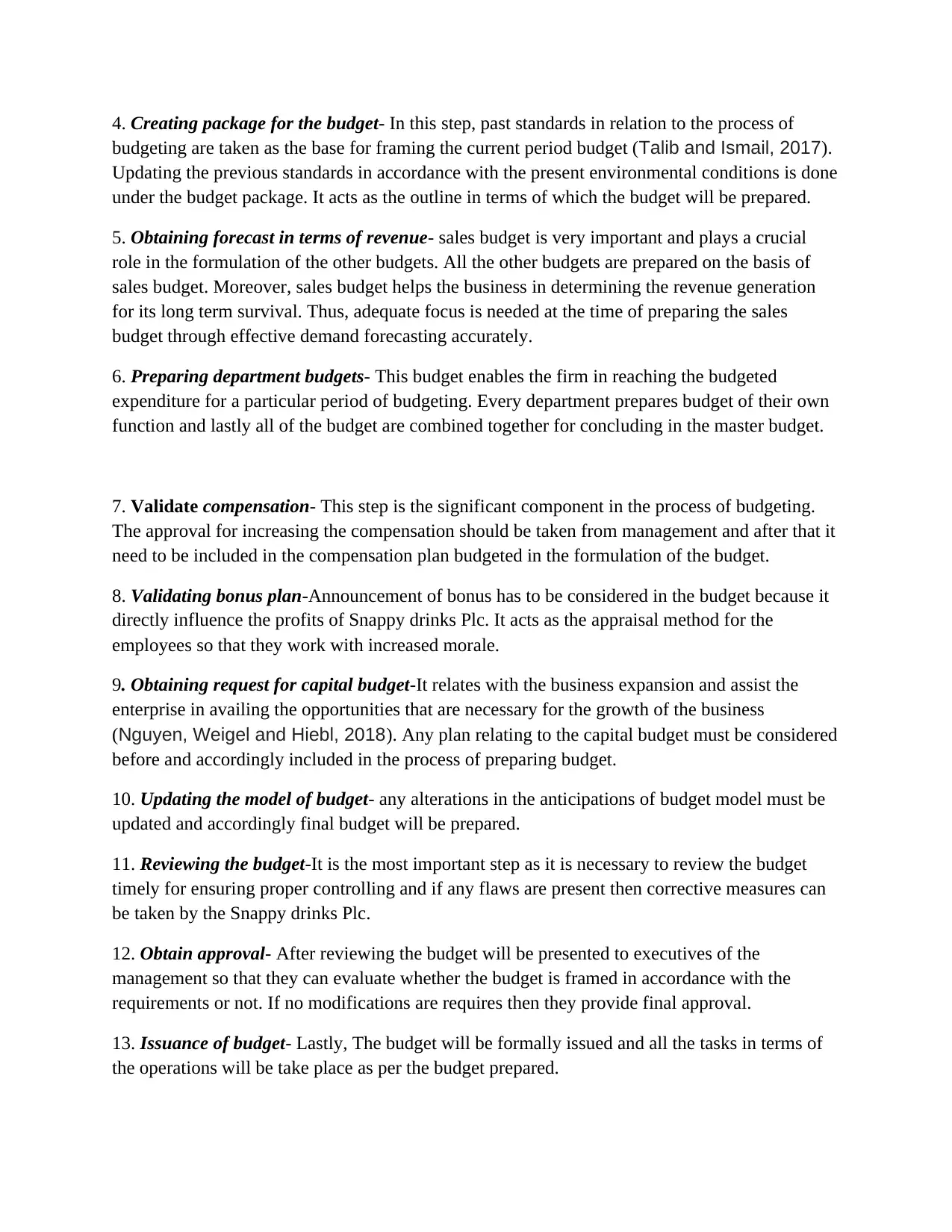
4. Creating package for the budget- In this step, past standards in relation to the process of
budgeting are taken as the base for framing the current period budget (Talib and Ismail, 2017).
Updating the previous standards in accordance with the present environmental conditions is done
under the budget package. It acts as the outline in terms of which the budget will be prepared.
5. Obtaining forecast in terms of revenue- sales budget is very important and plays a crucial
role in the formulation of the other budgets. All the other budgets are prepared on the basis of
sales budget. Moreover, sales budget helps the business in determining the revenue generation
for its long term survival. Thus, adequate focus is needed at the time of preparing the sales
budget through effective demand forecasting accurately.
6. Preparing department budgets- This budget enables the firm in reaching the budgeted
expenditure for a particular period of budgeting. Every department prepares budget of their own
function and lastly all of the budget are combined together for concluding in the master budget.
7. Validate compensation- This step is the significant component in the process of budgeting.
The approval for increasing the compensation should be taken from management and after that it
need to be included in the compensation plan budgeted in the formulation of the budget.
8. Validating bonus plan-Announcement of bonus has to be considered in the budget because it
directly influence the profits of Snappy drinks Plc. It acts as the appraisal method for the
employees so that they work with increased morale.
9. Obtaining request for capital budget-It relates with the business expansion and assist the
enterprise in availing the opportunities that are necessary for the growth of the business
(Nguyen, Weigel and Hiebl, 2018). Any plan relating to the capital budget must be considered
before and accordingly included in the process of preparing budget.
10. Updating the model of budget- any alterations in the anticipations of budget model must be
updated and accordingly final budget will be prepared.
11. Reviewing the budget-It is the most important step as it is necessary to review the budget
timely for ensuring proper controlling and if any flaws are present then corrective measures can
be taken by the Snappy drinks Plc.
12. Obtain approval- After reviewing the budget will be presented to executives of the
management so that they can evaluate whether the budget is framed in accordance with the
requirements or not. If no modifications are requires then they provide final approval.
13. Issuance of budget- Lastly, The budget will be formally issued and all the tasks in terms of
the operations will be take place as per the budget prepared.
budgeting are taken as the base for framing the current period budget (Talib and Ismail, 2017).
Updating the previous standards in accordance with the present environmental conditions is done
under the budget package. It acts as the outline in terms of which the budget will be prepared.
5. Obtaining forecast in terms of revenue- sales budget is very important and plays a crucial
role in the formulation of the other budgets. All the other budgets are prepared on the basis of
sales budget. Moreover, sales budget helps the business in determining the revenue generation
for its long term survival. Thus, adequate focus is needed at the time of preparing the sales
budget through effective demand forecasting accurately.
6. Preparing department budgets- This budget enables the firm in reaching the budgeted
expenditure for a particular period of budgeting. Every department prepares budget of their own
function and lastly all of the budget are combined together for concluding in the master budget.
7. Validate compensation- This step is the significant component in the process of budgeting.
The approval for increasing the compensation should be taken from management and after that it
need to be included in the compensation plan budgeted in the formulation of the budget.
8. Validating bonus plan-Announcement of bonus has to be considered in the budget because it
directly influence the profits of Snappy drinks Plc. It acts as the appraisal method for the
employees so that they work with increased morale.
9. Obtaining request for capital budget-It relates with the business expansion and assist the
enterprise in availing the opportunities that are necessary for the growth of the business
(Nguyen, Weigel and Hiebl, 2018). Any plan relating to the capital budget must be considered
before and accordingly included in the process of preparing budget.
10. Updating the model of budget- any alterations in the anticipations of budget model must be
updated and accordingly final budget will be prepared.
11. Reviewing the budget-It is the most important step as it is necessary to review the budget
timely for ensuring proper controlling and if any flaws are present then corrective measures can
be taken by the Snappy drinks Plc.
12. Obtain approval- After reviewing the budget will be presented to executives of the
management so that they can evaluate whether the budget is framed in accordance with the
requirements or not. If no modifications are requires then they provide final approval.
13. Issuance of budget- Lastly, The budget will be formally issued and all the tasks in terms of
the operations will be take place as per the budget prepared.
Paraphrase This Document
Need a fresh take? Get an instant paraphrase of this document with our AI Paraphraser
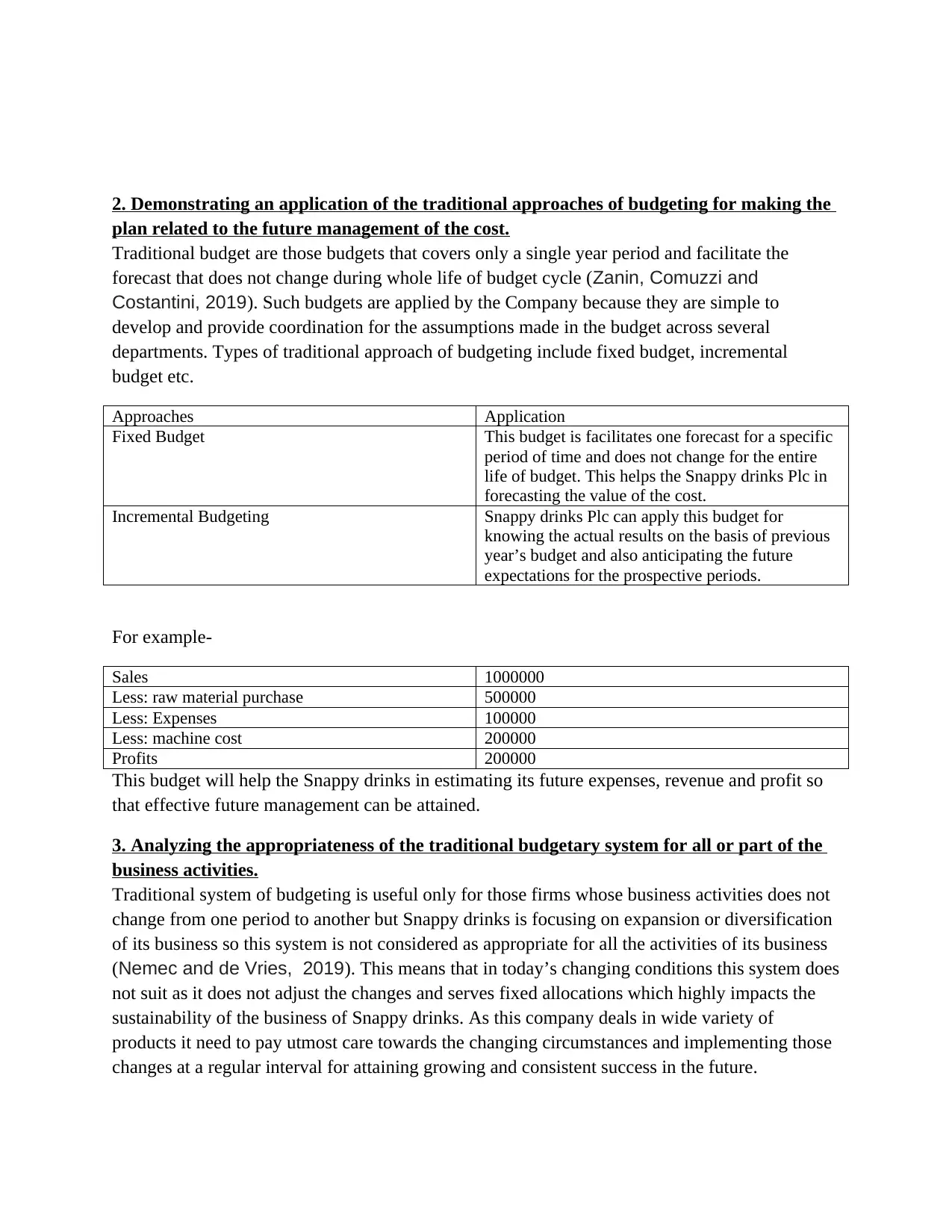
2. Demonstrating an application of the traditional approaches of budgeting for making the
plan related to the future management of the cost.
Traditional budget are those budgets that covers only a single year period and facilitate the
forecast that does not change during whole life of budget cycle (Zanin, Comuzzi and
Costantini, 2019). Such budgets are applied by the Company because they are simple to
develop and provide coordination for the assumptions made in the budget across several
departments. Types of traditional approach of budgeting include fixed budget, incremental
budget etc.
Approaches Application
Fixed Budget This budget is facilitates one forecast for a specific
period of time and does not change for the entire
life of budget. This helps the Snappy drinks Plc in
forecasting the value of the cost.
Incremental Budgeting Snappy drinks Plc can apply this budget for
knowing the actual results on the basis of previous
year’s budget and also anticipating the future
expectations for the prospective periods.
For example-
Sales 1000000
Less: raw material purchase 500000
Less: Expenses 100000
Less: machine cost 200000
Profits 200000
This budget will help the Snappy drinks in estimating its future expenses, revenue and profit so
that effective future management can be attained.
3. Analyzing the appropriateness of the traditional budgetary system for all or part of the
business activities.
Traditional system of budgeting is useful only for those firms whose business activities does not
change from one period to another but Snappy drinks is focusing on expansion or diversification
of its business so this system is not considered as appropriate for all the activities of its business
(Nemec and de Vries, 2019). This means that in today’s changing conditions this system does
not suit as it does not adjust the changes and serves fixed allocations which highly impacts the
sustainability of the business of Snappy drinks. As this company deals in wide variety of
products it need to pay utmost care towards the changing circumstances and implementing those
changes at a regular interval for attaining growing and consistent success in the future.
plan related to the future management of the cost.
Traditional budget are those budgets that covers only a single year period and facilitate the
forecast that does not change during whole life of budget cycle (Zanin, Comuzzi and
Costantini, 2019). Such budgets are applied by the Company because they are simple to
develop and provide coordination for the assumptions made in the budget across several
departments. Types of traditional approach of budgeting include fixed budget, incremental
budget etc.
Approaches Application
Fixed Budget This budget is facilitates one forecast for a specific
period of time and does not change for the entire
life of budget. This helps the Snappy drinks Plc in
forecasting the value of the cost.
Incremental Budgeting Snappy drinks Plc can apply this budget for
knowing the actual results on the basis of previous
year’s budget and also anticipating the future
expectations for the prospective periods.
For example-
Sales 1000000
Less: raw material purchase 500000
Less: Expenses 100000
Less: machine cost 200000
Profits 200000
This budget will help the Snappy drinks in estimating its future expenses, revenue and profit so
that effective future management can be attained.
3. Analyzing the appropriateness of the traditional budgetary system for all or part of the
business activities.
Traditional system of budgeting is useful only for those firms whose business activities does not
change from one period to another but Snappy drinks is focusing on expansion or diversification
of its business so this system is not considered as appropriate for all the activities of its business
(Nemec and de Vries, 2019). This means that in today’s changing conditions this system does
not suit as it does not adjust the changes and serves fixed allocations which highly impacts the
sustainability of the business of Snappy drinks. As this company deals in wide variety of
products it need to pay utmost care towards the changing circumstances and implementing those
changes at a regular interval for attaining growing and consistent success in the future.
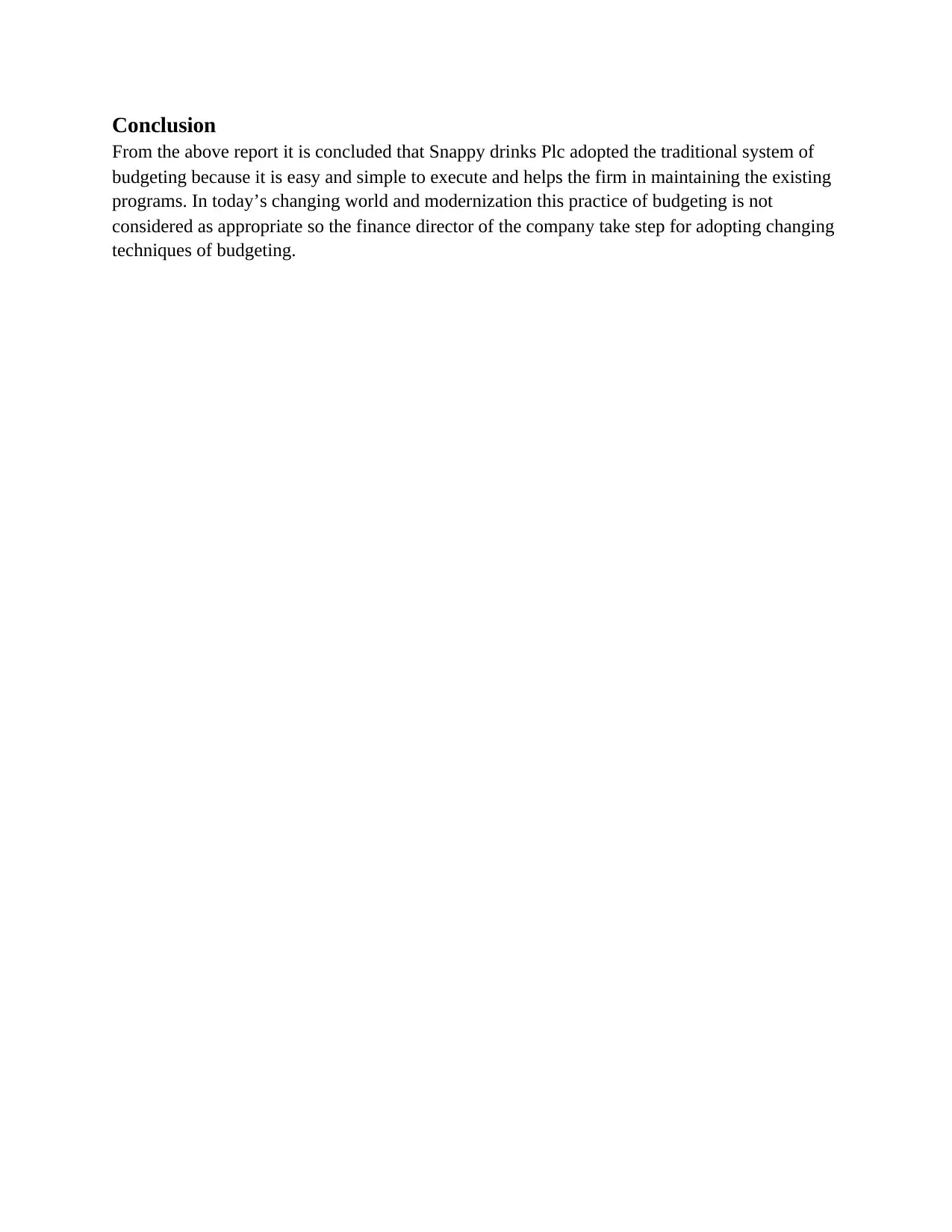
Conclusion
From the above report it is concluded that Snappy drinks Plc adopted the traditional system of
budgeting because it is easy and simple to execute and helps the firm in maintaining the existing
programs. In today’s changing world and modernization this practice of budgeting is not
considered as appropriate so the finance director of the company take step for adopting changing
techniques of budgeting.
From the above report it is concluded that Snappy drinks Plc adopted the traditional system of
budgeting because it is easy and simple to execute and helps the firm in maintaining the existing
programs. In today’s changing world and modernization this practice of budgeting is not
considered as appropriate so the finance director of the company take step for adopting changing
techniques of budgeting.
⊘ This is a preview!⊘
Do you want full access?
Subscribe today to unlock all pages.

Trusted by 1+ million students worldwide
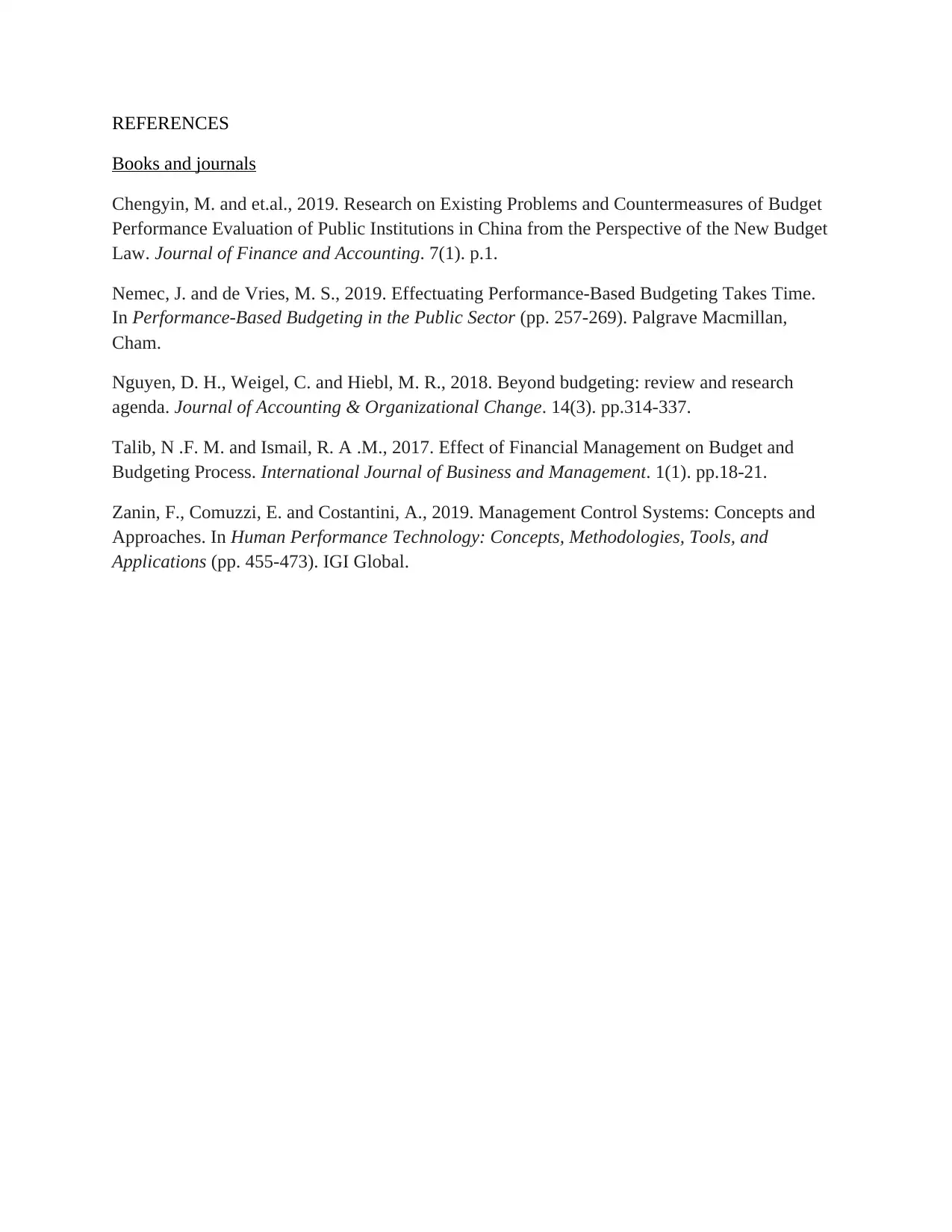
REFERENCES
Books and journals
Chengyin, M. and et.al., 2019. Research on Existing Problems and Countermeasures of Budget
Performance Evaluation of Public Institutions in China from the Perspective of the New Budget
Law. Journal of Finance and Accounting. 7(1). p.1.
Nemec, J. and de Vries, M. S., 2019. Effectuating Performance-Based Budgeting Takes Time.
In Performance-Based Budgeting in the Public Sector (pp. 257-269). Palgrave Macmillan,
Cham.
Nguyen, D. H., Weigel, C. and Hiebl, M. R., 2018. Beyond budgeting: review and research
agenda. Journal of Accounting & Organizational Change. 14(3). pp.314-337.
Talib, N .F. M. and Ismail, R. A .M., 2017. Effect of Financial Management on Budget and
Budgeting Process. International Journal of Business and Management. 1(1). pp.18-21.
Zanin, F., Comuzzi, E. and Costantini, A., 2019. Management Control Systems: Concepts and
Approaches. In Human Performance Technology: Concepts, Methodologies, Tools, and
Applications (pp. 455-473). IGI Global.
Books and journals
Chengyin, M. and et.al., 2019. Research on Existing Problems and Countermeasures of Budget
Performance Evaluation of Public Institutions in China from the Perspective of the New Budget
Law. Journal of Finance and Accounting. 7(1). p.1.
Nemec, J. and de Vries, M. S., 2019. Effectuating Performance-Based Budgeting Takes Time.
In Performance-Based Budgeting in the Public Sector (pp. 257-269). Palgrave Macmillan,
Cham.
Nguyen, D. H., Weigel, C. and Hiebl, M. R., 2018. Beyond budgeting: review and research
agenda. Journal of Accounting & Organizational Change. 14(3). pp.314-337.
Talib, N .F. M. and Ismail, R. A .M., 2017. Effect of Financial Management on Budget and
Budgeting Process. International Journal of Business and Management. 1(1). pp.18-21.
Zanin, F., Comuzzi, E. and Costantini, A., 2019. Management Control Systems: Concepts and
Approaches. In Human Performance Technology: Concepts, Methodologies, Tools, and
Applications (pp. 455-473). IGI Global.
Paraphrase This Document
Need a fresh take? Get an instant paraphrase of this document with our AI Paraphraser
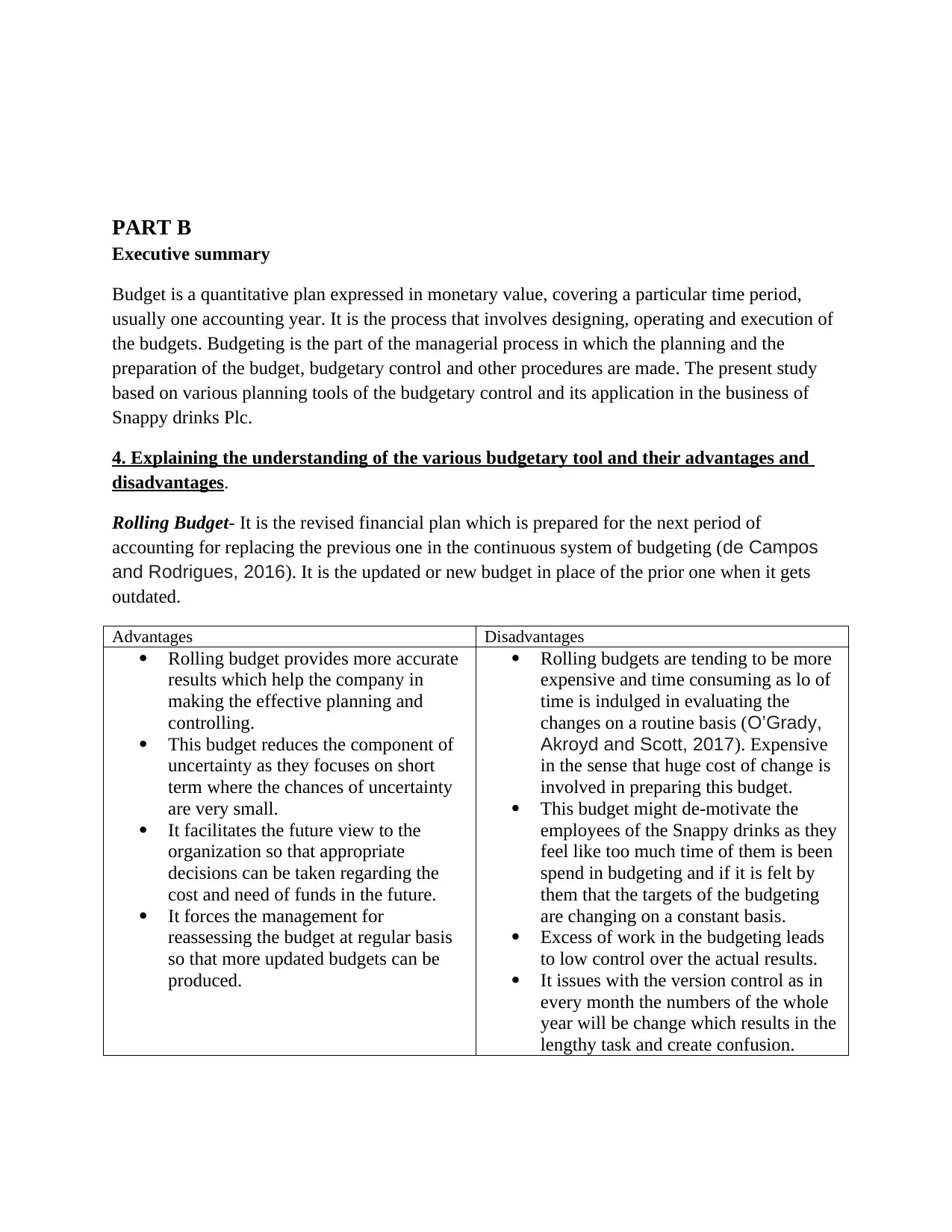
PART B
Executive summary
Budget is a quantitative plan expressed in monetary value, covering a particular time period,
usually one accounting year. It is the process that involves designing, operating and execution of
the budgets. Budgeting is the part of the managerial process in which the planning and the
preparation of the budget, budgetary control and other procedures are made. The present study
based on various planning tools of the budgetary control and its application in the business of
Snappy drinks Plc.
4. Explaining the understanding of the various budgetary tool and their advantages and
disadvantages.
Rolling Budget- It is the revised financial plan which is prepared for the next period of
accounting for replacing the previous one in the continuous system of budgeting (de Campos
and Rodrigues, 2016). It is the updated or new budget in place of the prior one when it gets
outdated.
Advantages Disadvantages
Rolling budget provides more accurate
results which help the company in
making the effective planning and
controlling.
This budget reduces the component of
uncertainty as they focuses on short
term where the chances of uncertainty
are very small.
It facilitates the future view to the
organization so that appropriate
decisions can be taken regarding the
cost and need of funds in the future.
It forces the management for
reassessing the budget at regular basis
so that more updated budgets can be
produced.
Rolling budgets are tending to be more
expensive and time consuming as lo of
time is indulged in evaluating the
changes on a routine basis (O’Grady,
Akroyd and Scott, 2017). Expensive
in the sense that huge cost of change is
involved in preparing this budget.
This budget might de-motivate the
employees of the Snappy drinks as they
feel like too much time of them is been
spend in budgeting and if it is felt by
them that the targets of the budgeting
are changing on a constant basis.
Excess of work in the budgeting leads
to low control over the actual results.
It issues with the version control as in
every month the numbers of the whole
year will be change which results in the
lengthy task and create confusion.
Executive summary
Budget is a quantitative plan expressed in monetary value, covering a particular time period,
usually one accounting year. It is the process that involves designing, operating and execution of
the budgets. Budgeting is the part of the managerial process in which the planning and the
preparation of the budget, budgetary control and other procedures are made. The present study
based on various planning tools of the budgetary control and its application in the business of
Snappy drinks Plc.
4. Explaining the understanding of the various budgetary tool and their advantages and
disadvantages.
Rolling Budget- It is the revised financial plan which is prepared for the next period of
accounting for replacing the previous one in the continuous system of budgeting (de Campos
and Rodrigues, 2016). It is the updated or new budget in place of the prior one when it gets
outdated.
Advantages Disadvantages
Rolling budget provides more accurate
results which help the company in
making the effective planning and
controlling.
This budget reduces the component of
uncertainty as they focuses on short
term where the chances of uncertainty
are very small.
It facilitates the future view to the
organization so that appropriate
decisions can be taken regarding the
cost and need of funds in the future.
It forces the management for
reassessing the budget at regular basis
so that more updated budgets can be
produced.
Rolling budgets are tending to be more
expensive and time consuming as lo of
time is indulged in evaluating the
changes on a routine basis (O’Grady,
Akroyd and Scott, 2017). Expensive
in the sense that huge cost of change is
involved in preparing this budget.
This budget might de-motivate the
employees of the Snappy drinks as they
feel like too much time of them is been
spend in budgeting and if it is felt by
them that the targets of the budgeting
are changing on a constant basis.
Excess of work in the budgeting leads
to low control over the actual results.
It issues with the version control as in
every month the numbers of the whole
year will be change which results in the
lengthy task and create confusion.
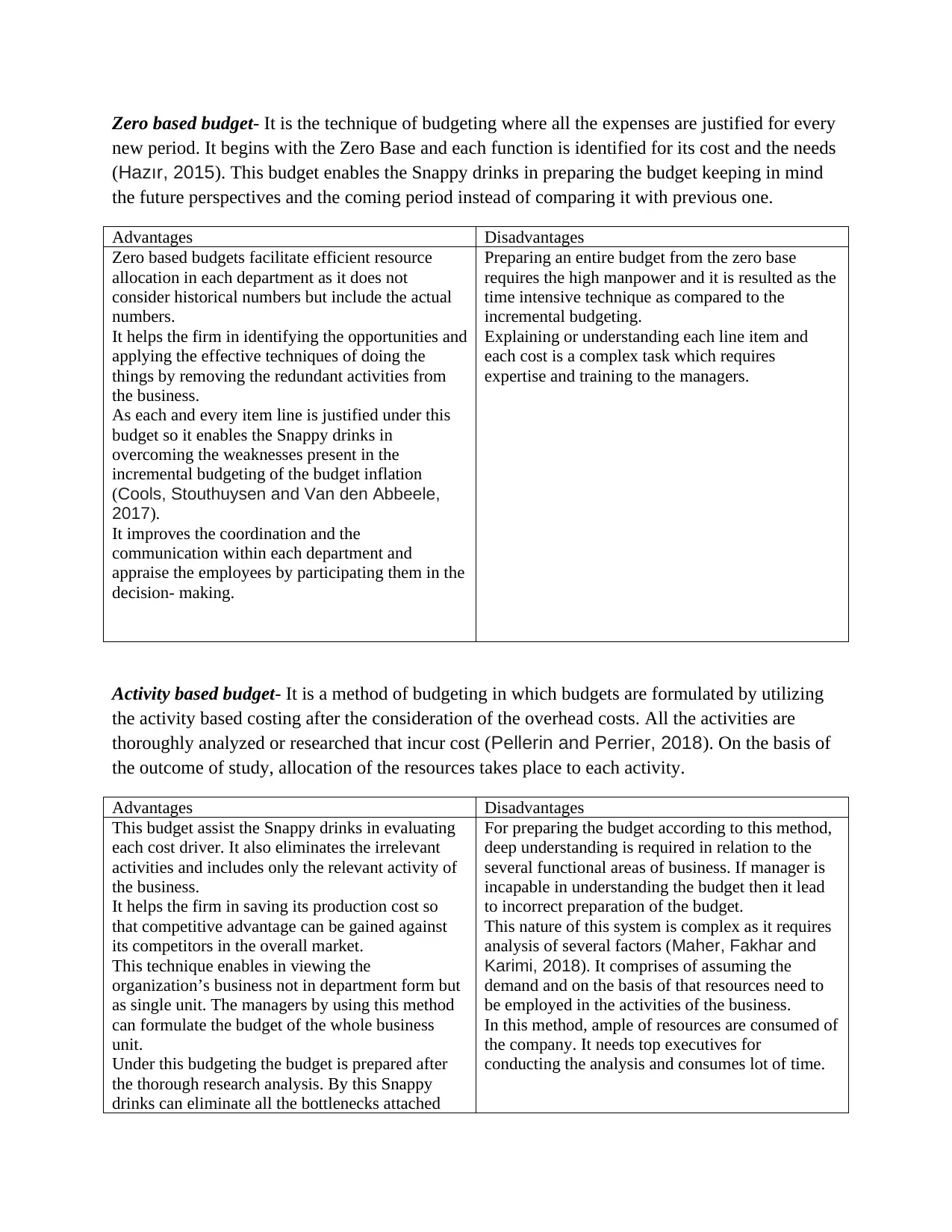
Zero based budget- It is the technique of budgeting where all the expenses are justified for every
new period. It begins with the Zero Base and each function is identified for its cost and the needs
(Hazır, 2015). This budget enables the Snappy drinks in preparing the budget keeping in mind
the future perspectives and the coming period instead of comparing it with previous one.
Advantages Disadvantages
Zero based budgets facilitate efficient resource
allocation in each department as it does not
consider historical numbers but include the actual
numbers.
It helps the firm in identifying the opportunities and
applying the effective techniques of doing the
things by removing the redundant activities from
the business.
As each and every item line is justified under this
budget so it enables the Snappy drinks in
overcoming the weaknesses present in the
incremental budgeting of the budget inflation
(Cools, Stouthuysen and Van den Abbeele,
2017).
It improves the coordination and the
communication within each department and
appraise the employees by participating them in the
decision- making.
Preparing an entire budget from the zero base
requires the high manpower and it is resulted as the
time intensive technique as compared to the
incremental budgeting.
Explaining or understanding each line item and
each cost is a complex task which requires
expertise and training to the managers.
Activity based budget- It is a method of budgeting in which budgets are formulated by utilizing
the activity based costing after the consideration of the overhead costs. All the activities are
thoroughly analyzed or researched that incur cost (Pellerin and Perrier, 2018). On the basis of
the outcome of study, allocation of the resources takes place to each activity.
Advantages Disadvantages
This budget assist the Snappy drinks in evaluating
each cost driver. It also eliminates the irrelevant
activities and includes only the relevant activity of
the business.
It helps the firm in saving its production cost so
that competitive advantage can be gained against
its competitors in the overall market.
This technique enables in viewing the
organization’s business not in department form but
as single unit. The managers by using this method
can formulate the budget of the whole business
unit.
Under this budgeting the budget is prepared after
the thorough research analysis. By this Snappy
drinks can eliminate all the bottlenecks attached
For preparing the budget according to this method,
deep understanding is required in relation to the
several functional areas of business. If manager is
incapable in understanding the budget then it lead
to incorrect preparation of the budget.
This nature of this system is complex as it requires
analysis of several factors (Maher, Fakhar and
Karimi, 2018). It comprises of assuming the
demand and on the basis of that resources need to
be employed in the activities of the business.
In this method, ample of resources are consumed of
the company. It needs top executives for
conducting the analysis and consumes lot of time.
new period. It begins with the Zero Base and each function is identified for its cost and the needs
(Hazır, 2015). This budget enables the Snappy drinks in preparing the budget keeping in mind
the future perspectives and the coming period instead of comparing it with previous one.
Advantages Disadvantages
Zero based budgets facilitate efficient resource
allocation in each department as it does not
consider historical numbers but include the actual
numbers.
It helps the firm in identifying the opportunities and
applying the effective techniques of doing the
things by removing the redundant activities from
the business.
As each and every item line is justified under this
budget so it enables the Snappy drinks in
overcoming the weaknesses present in the
incremental budgeting of the budget inflation
(Cools, Stouthuysen and Van den Abbeele,
2017).
It improves the coordination and the
communication within each department and
appraise the employees by participating them in the
decision- making.
Preparing an entire budget from the zero base
requires the high manpower and it is resulted as the
time intensive technique as compared to the
incremental budgeting.
Explaining or understanding each line item and
each cost is a complex task which requires
expertise and training to the managers.
Activity based budget- It is a method of budgeting in which budgets are formulated by utilizing
the activity based costing after the consideration of the overhead costs. All the activities are
thoroughly analyzed or researched that incur cost (Pellerin and Perrier, 2018). On the basis of
the outcome of study, allocation of the resources takes place to each activity.
Advantages Disadvantages
This budget assist the Snappy drinks in evaluating
each cost driver. It also eliminates the irrelevant
activities and includes only the relevant activity of
the business.
It helps the firm in saving its production cost so
that competitive advantage can be gained against
its competitors in the overall market.
This technique enables in viewing the
organization’s business not in department form but
as single unit. The managers by using this method
can formulate the budget of the whole business
unit.
Under this budgeting the budget is prepared after
the thorough research analysis. By this Snappy
drinks can eliminate all the bottlenecks attached
For preparing the budget according to this method,
deep understanding is required in relation to the
several functional areas of business. If manager is
incapable in understanding the budget then it lead
to incorrect preparation of the budget.
This nature of this system is complex as it requires
analysis of several factors (Maher, Fakhar and
Karimi, 2018). It comprises of assuming the
demand and on the basis of that resources need to
be employed in the activities of the business.
In this method, ample of resources are consumed of
the company. It needs top executives for
conducting the analysis and consumes lot of time.
⊘ This is a preview!⊘
Do you want full access?
Subscribe today to unlock all pages.

Trusted by 1+ million students worldwide
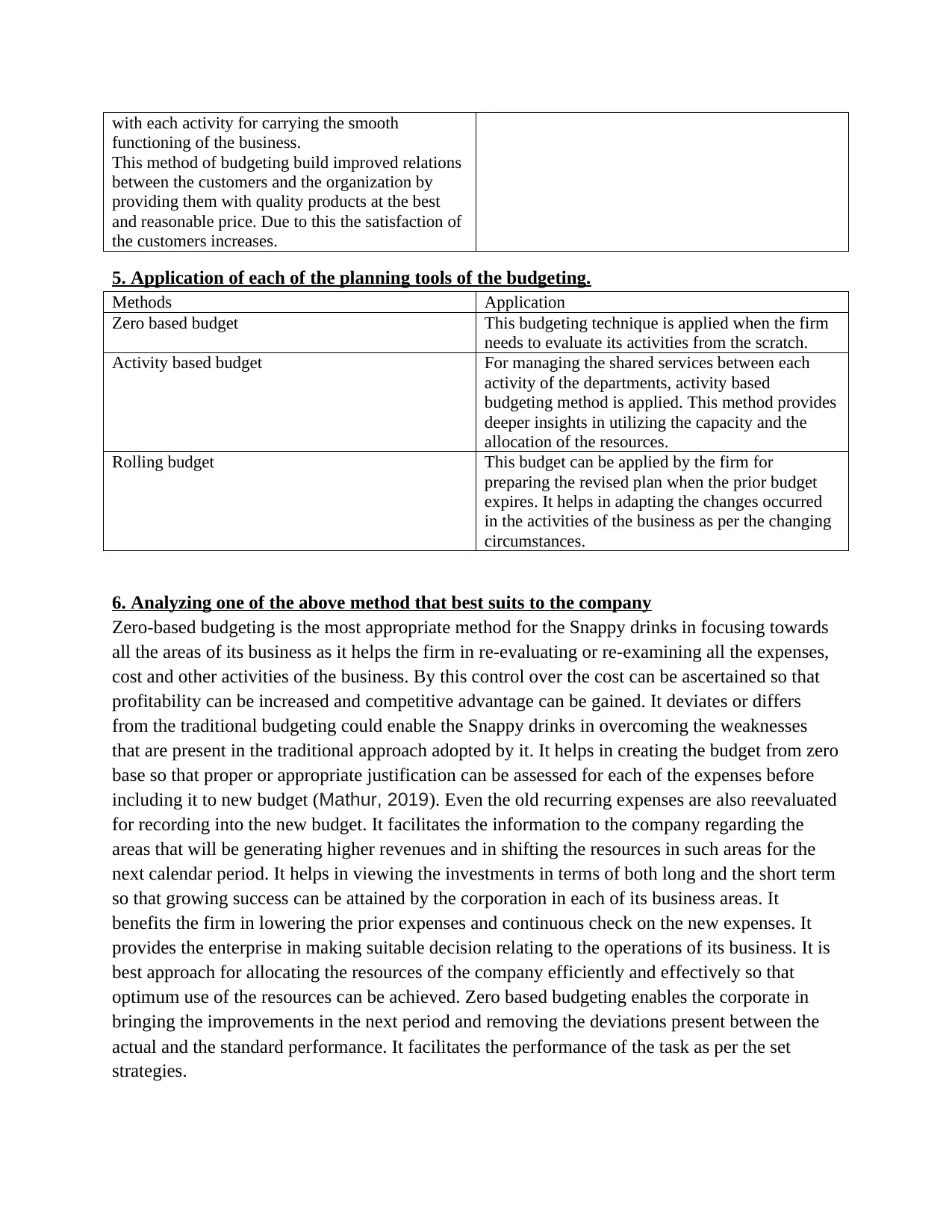
with each activity for carrying the smooth
functioning of the business.
This method of budgeting build improved relations
between the customers and the organization by
providing them with quality products at the best
and reasonable price. Due to this the satisfaction of
the customers increases.
5. Application of each of the planning tools of the budgeting.
Methods Application
Zero based budget This budgeting technique is applied when the firm
needs to evaluate its activities from the scratch.
Activity based budget For managing the shared services between each
activity of the departments, activity based
budgeting method is applied. This method provides
deeper insights in utilizing the capacity and the
allocation of the resources.
Rolling budget This budget can be applied by the firm for
preparing the revised plan when the prior budget
expires. It helps in adapting the changes occurred
in the activities of the business as per the changing
circumstances.
6. Analyzing one of the above method that best suits to the company
Zero-based budgeting is the most appropriate method for the Snappy drinks in focusing towards
all the areas of its business as it helps the firm in re-evaluating or re-examining all the expenses,
cost and other activities of the business. By this control over the cost can be ascertained so that
profitability can be increased and competitive advantage can be gained. It deviates or differs
from the traditional budgeting could enable the Snappy drinks in overcoming the weaknesses
that are present in the traditional approach adopted by it. It helps in creating the budget from zero
base so that proper or appropriate justification can be assessed for each of the expenses before
including it to new budget (Mathur, 2019). Even the old recurring expenses are also reevaluated
for recording into the new budget. It facilitates the information to the company regarding the
areas that will be generating higher revenues and in shifting the resources in such areas for the
next calendar period. It helps in viewing the investments in terms of both long and the short term
so that growing success can be attained by the corporation in each of its business areas. It
benefits the firm in lowering the prior expenses and continuous check on the new expenses. It
provides the enterprise in making suitable decision relating to the operations of its business. It is
best approach for allocating the resources of the company efficiently and effectively so that
optimum use of the resources can be achieved. Zero based budgeting enables the corporate in
bringing the improvements in the next period and removing the deviations present between the
actual and the standard performance. It facilitates the performance of the task as per the set
strategies.
functioning of the business.
This method of budgeting build improved relations
between the customers and the organization by
providing them with quality products at the best
and reasonable price. Due to this the satisfaction of
the customers increases.
5. Application of each of the planning tools of the budgeting.
Methods Application
Zero based budget This budgeting technique is applied when the firm
needs to evaluate its activities from the scratch.
Activity based budget For managing the shared services between each
activity of the departments, activity based
budgeting method is applied. This method provides
deeper insights in utilizing the capacity and the
allocation of the resources.
Rolling budget This budget can be applied by the firm for
preparing the revised plan when the prior budget
expires. It helps in adapting the changes occurred
in the activities of the business as per the changing
circumstances.
6. Analyzing one of the above method that best suits to the company
Zero-based budgeting is the most appropriate method for the Snappy drinks in focusing towards
all the areas of its business as it helps the firm in re-evaluating or re-examining all the expenses,
cost and other activities of the business. By this control over the cost can be ascertained so that
profitability can be increased and competitive advantage can be gained. It deviates or differs
from the traditional budgeting could enable the Snappy drinks in overcoming the weaknesses
that are present in the traditional approach adopted by it. It helps in creating the budget from zero
base so that proper or appropriate justification can be assessed for each of the expenses before
including it to new budget (Mathur, 2019). Even the old recurring expenses are also reevaluated
for recording into the new budget. It facilitates the information to the company regarding the
areas that will be generating higher revenues and in shifting the resources in such areas for the
next calendar period. It helps in viewing the investments in terms of both long and the short term
so that growing success can be attained by the corporation in each of its business areas. It
benefits the firm in lowering the prior expenses and continuous check on the new expenses. It
provides the enterprise in making suitable decision relating to the operations of its business. It is
best approach for allocating the resources of the company efficiently and effectively so that
optimum use of the resources can be achieved. Zero based budgeting enables the corporate in
bringing the improvements in the next period and removing the deviations present between the
actual and the standard performance. It facilitates the performance of the task as per the set
strategies.
Paraphrase This Document
Need a fresh take? Get an instant paraphrase of this document with our AI Paraphraser
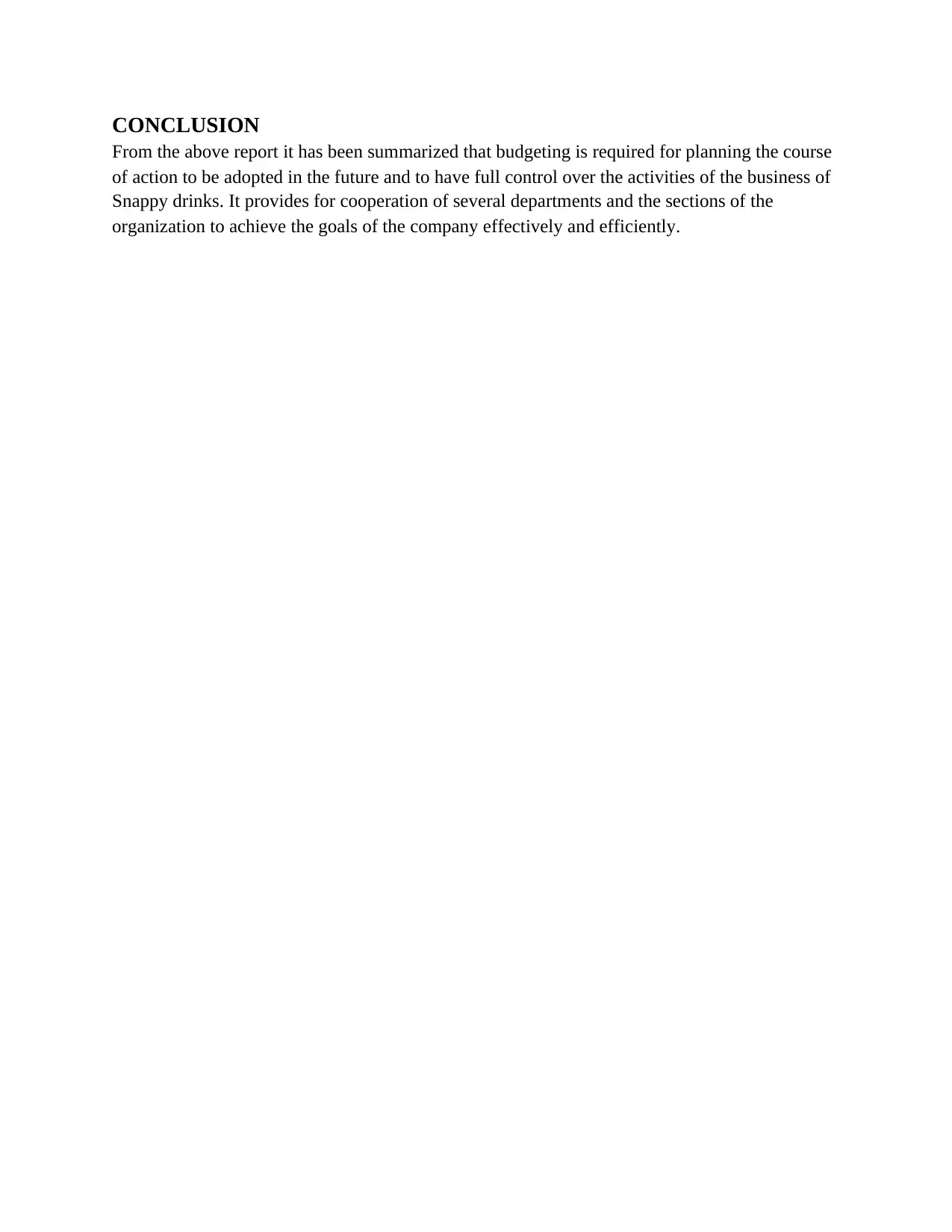
CONCLUSION
From the above report it has been summarized that budgeting is required for planning the course
of action to be adopted in the future and to have full control over the activities of the business of
Snappy drinks. It provides for cooperation of several departments and the sections of the
organization to achieve the goals of the company effectively and efficiently.
From the above report it has been summarized that budgeting is required for planning the course
of action to be adopted in the future and to have full control over the activities of the business of
Snappy drinks. It provides for cooperation of several departments and the sections of the
organization to achieve the goals of the company effectively and efficiently.
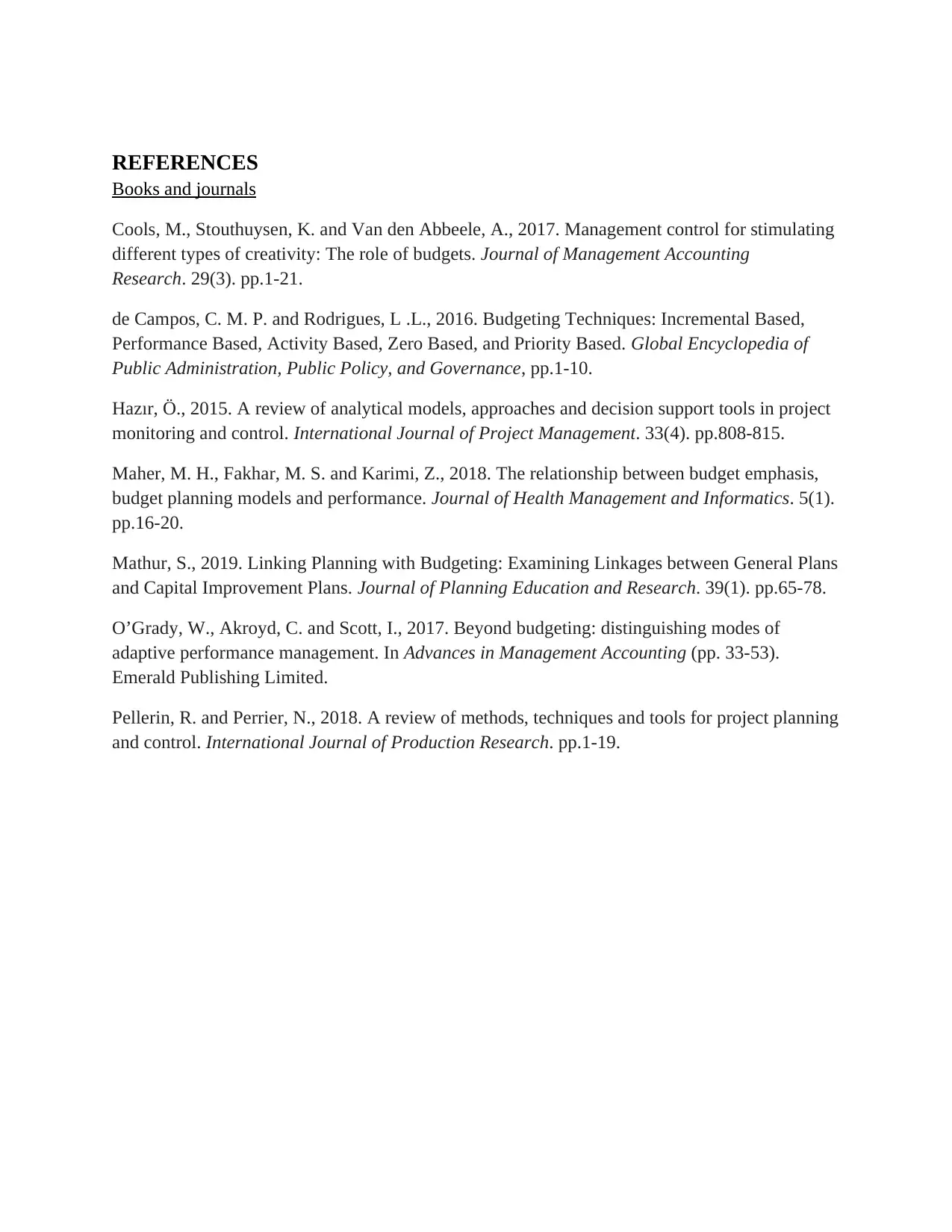
REFERENCES
Books and journals
Cools, M., Stouthuysen, K. and Van den Abbeele, A., 2017. Management control for stimulating
different types of creativity: The role of budgets. Journal of Management Accounting
Research. 29(3). pp.1-21.
de Campos, C. M. P. and Rodrigues, L .L., 2016. Budgeting Techniques: Incremental Based,
Performance Based, Activity Based, Zero Based, and Priority Based. Global Encyclopedia of
Public Administration, Public Policy, and Governance, pp.1-10.
Hazır, Ö., 2015. A review of analytical models, approaches and decision support tools in project
monitoring and control. International Journal of Project Management. 33(4). pp.808-815.
Maher, M. H., Fakhar, M. S. and Karimi, Z., 2018. The relationship between budget emphasis,
budget planning models and performance. Journal of Health Management and Informatics. 5(1).
pp.16-20.
Mathur, S., 2019. Linking Planning with Budgeting: Examining Linkages between General Plans
and Capital Improvement Plans. Journal of Planning Education and Research. 39(1). pp.65-78.
O’Grady, W., Akroyd, C. and Scott, I., 2017. Beyond budgeting: distinguishing modes of
adaptive performance management. In Advances in Management Accounting (pp. 33-53).
Emerald Publishing Limited.
Pellerin, R. and Perrier, N., 2018. A review of methods, techniques and tools for project planning
and control. International Journal of Production Research. pp.1-19.
Books and journals
Cools, M., Stouthuysen, K. and Van den Abbeele, A., 2017. Management control for stimulating
different types of creativity: The role of budgets. Journal of Management Accounting
Research. 29(3). pp.1-21.
de Campos, C. M. P. and Rodrigues, L .L., 2016. Budgeting Techniques: Incremental Based,
Performance Based, Activity Based, Zero Based, and Priority Based. Global Encyclopedia of
Public Administration, Public Policy, and Governance, pp.1-10.
Hazır, Ö., 2015. A review of analytical models, approaches and decision support tools in project
monitoring and control. International Journal of Project Management. 33(4). pp.808-815.
Maher, M. H., Fakhar, M. S. and Karimi, Z., 2018. The relationship between budget emphasis,
budget planning models and performance. Journal of Health Management and Informatics. 5(1).
pp.16-20.
Mathur, S., 2019. Linking Planning with Budgeting: Examining Linkages between General Plans
and Capital Improvement Plans. Journal of Planning Education and Research. 39(1). pp.65-78.
O’Grady, W., Akroyd, C. and Scott, I., 2017. Beyond budgeting: distinguishing modes of
adaptive performance management. In Advances in Management Accounting (pp. 33-53).
Emerald Publishing Limited.
Pellerin, R. and Perrier, N., 2018. A review of methods, techniques and tools for project planning
and control. International Journal of Production Research. pp.1-19.
⊘ This is a preview!⊘
Do you want full access?
Subscribe today to unlock all pages.

Trusted by 1+ million students worldwide
1 out of 12
Related Documents
Your All-in-One AI-Powered Toolkit for Academic Success.
+13062052269
info@desklib.com
Available 24*7 on WhatsApp / Email
![[object Object]](/_next/static/media/star-bottom.7253800d.svg)
Unlock your academic potential
Copyright © 2020–2025 A2Z Services. All Rights Reserved. Developed and managed by ZUCOL.





